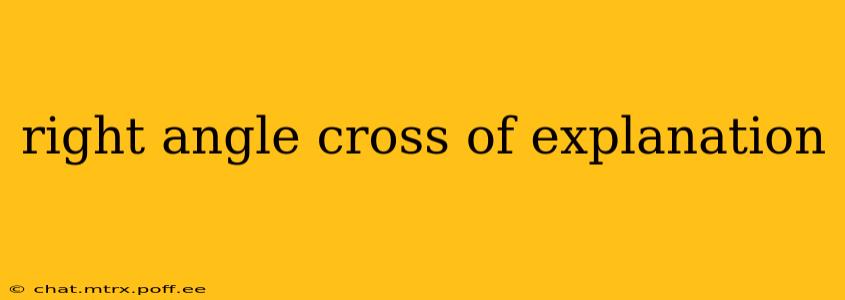Understanding the Right Angle Cross: A Comprehensive Explanation
The term "right angle cross" isn't a standard, universally recognized term in mathematics, engineering, or any specific field. It's likely referring to a specific visual representation or a concept within a particular context. To provide a comprehensive explanation, we need to explore several possibilities and address potential interpretations.
This explanation will cover several scenarios that could be implied by "right angle cross," offering detailed insights and addressing common questions.
What are some possible interpretations of a "right angle cross"?
This phrase could refer to several different things, depending on the context:
-
A cross shape with right angles: This could simply describe a cross where the intersecting lines meet at 90-degree angles, forming four right angles. This is the most straightforward interpretation. This type of cross is frequently seen in various contexts, from simple diagrams to more complex designs. The size and proportions of the arms can vary greatly.
-
A symbol or diagram in a specific field: Some specialized fields might use the term "right angle cross" to denote a particular symbol or diagram with specific meaning. Without knowing the context, this remains speculative.
-
A geometrical construction: In geometry, a right angle cross could refer to a specific construction involving perpendicular lines and the creation of right angles. The construction method might involve drawing perpendicular bisectors or using compass and straightedge tools.
-
A reference in a specific book or document: If you encountered this phrase in a particular text, providing that context would help clarify its meaning. Looking for more information within that document or book will likely provide the most accurate definition.
How is a right angle cross used in different contexts?
The applications of a simple right angle cross are surprisingly diverse:
-
Cartography and Mapping: A stylized right-angle cross might represent a specific feature or landmark on a map.
-
Engineering and Design: Right angles are fundamental in structural engineering and design. A right angle cross could be a simplification of a complex structure or a key element in a design schematic.
-
Symbols and Iconography: In some cultural or religious contexts, a cross with right angles may carry symbolic meaning.
-
Simple Diagrams and Visualizations: A basic right angle cross is frequently used in diagrams to illustrate relationships, connections, or intersections.
What are some common uses of right angles in general?
Understanding the importance of right angles in various fields helps clarify why a "right angle cross" might be significant in a particular context. Right angles are fundamental because:
-
Stability and Strength: In construction and engineering, structures built with right angles tend to be more stable and structurally sound.
-
Simplicity and Ease of Calculation: Right angles simplify many calculations in geometry and trigonometry.
-
Precise Measurement and Alignment: Right angles are essential for precise measurements and alignments in various fields.
Can you provide examples of right angle crosses in real-world applications?
While there isn't a single standardized "right angle cross" symbol, consider the following as examples of structures or symbols incorporating right angles:
-
The "+" symbol: This is a basic representation of a right angle cross. It's ubiquitous in mathematics, computing, and various other fields.
-
The intersection of roads or streets: The meeting point of two perpendicular roads visually represents a right angle cross.
-
Simple structural supports: Many buildings use beams or supports forming right angles for structural integrity.
-
Grid systems: Grid systems, commonly used in urban planning and design, employ a network of right angles.
To provide a more specific and tailored answer, please provide more context on where you encountered the term "right angle cross." Knowing the source will greatly enhance my ability to offer a precise and relevant explanation.
